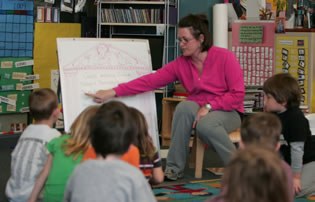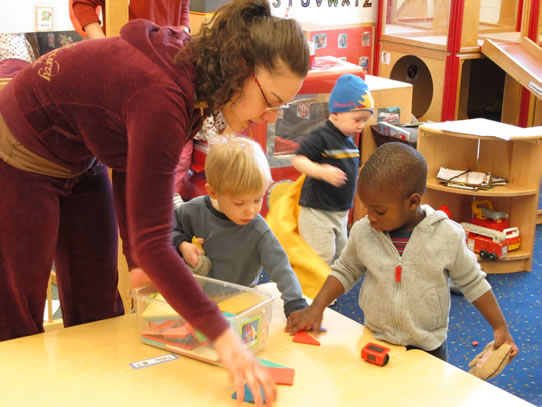Ideas for creating a calming environment and encouraging prosocial behavior. Children have the opportunity to hear and see many unsettling, often violent images through television, newspapers, radio, and electronic games. As caregivers to young children, what can we do to create peaceful environments that children need?

Welcome!
Think of how you feel entering a room of people. When you are greeted warmly, it conveys a positive atmosphere; someone cares that you are there. Apply this to children by greeting them by name and welcoming them at eye level (with a smile!). Adults caring for children can set the emotional tone of the room. If adults are positive, caring, and attentive, the environment in the room will begin to reflect this.
Consider simple additions, such as displaying family photos, class photos, children's art/projects, and a welcome sign. Incorporate other home-like additions, such as warm lighting and cozy materials (pillows, blankets, comfortable chairs).
The environment will reflect each child as well as the group, and also convey a sense of home.
Group work
Children need to feel part of a group or family. Provide group times such as eating times, project times, and meeting times. It is in these groups that children will become aware of each other and gain a sense of the class as a whole.
It is also in these group times that children are instilled with a sense of responsibility to care for each other and for the environment. Have the children, along with the adults, think of rules or "living ideas" for the group. State and write the rules in a positive manner, such as "We use inside voices" vs. "No yelling." This is an important time for both children and adults to share ideas, especially in solving conflicts. Offering children the voice to discuss and make decisions means that they are an important, competent member of the group.
Natural connections
Nature has a way of adding beauty, a sense of calm, and creativity to any environment. Create opportunities daily to expose children to the outside world, especially getting outdoors to play! The fresh air and physical exercise will provide a pathway to good health. Research shows that children who are physically healthy are happier. Happier children create happier environments.
Display beautiful items from nature in the inside environment (especially those the children discovered!) such as sea shells, leaves, flowers, rocks, interesting sticks, and plants. The children begin to see the adult's respect and awe for natural materials, and also show a sense of honoring and caring for something. Caring for nature reflects caring for each other.
Engaging Environments
Lots of time and space to explore, along with developmentally appropriate, interesting, creative materials, help children focus. Boredom or having nothing to do can be the cause for unwanted behaviors, but a child happily involved in play reflects an engaging environment and in return supports peaceful environments.
Be a peaceful role model
 Guiding and offering peaceful solutions to children during conflict is one of the most important skills offered to children. Even at an early age, children can learn to start problem solving and resolving conflicts. Model words to encourage sharing and turn taking:
Guiding and offering peaceful solutions to children during conflict is one of the most important skills offered to children. Even at an early age, children can learn to start problem solving and resolving conflicts. Model words to encourage sharing and turn taking:
- "You both want a turn with the doll. How can you both get a turn?"
- "Tim is using the car. Did you want to ask him for a turn?"
- "How can we help each other?"
A child happily involved in play reflects an engaging environment and in return supports peaceful environments.
Role playing is important in practicing problem solving. Offer the children problems to try and solve. Use everyday experiences that the children are working on (sharing, clean-up, being kind) without using names. It is helpful to practice with puppets or small animal (or people) figurines.
Peaceful environments take time to build and take continual care in order to maintain. In the process of creating and implementing peaceful environments, we are in turn nurturing peaceful and caring children.
Sources:
Levin, Diane E. 2003. Teaching Young Children in Violent Times: Building a Peaceable Classroom, second edition. Washington, DC: co-published by NAEYC and Educators for Social Responsibility.
Klein, Amy S. "Creating peaceful environmental designs for the classroom." retrieved November 24, 2003
Tips 8-1

